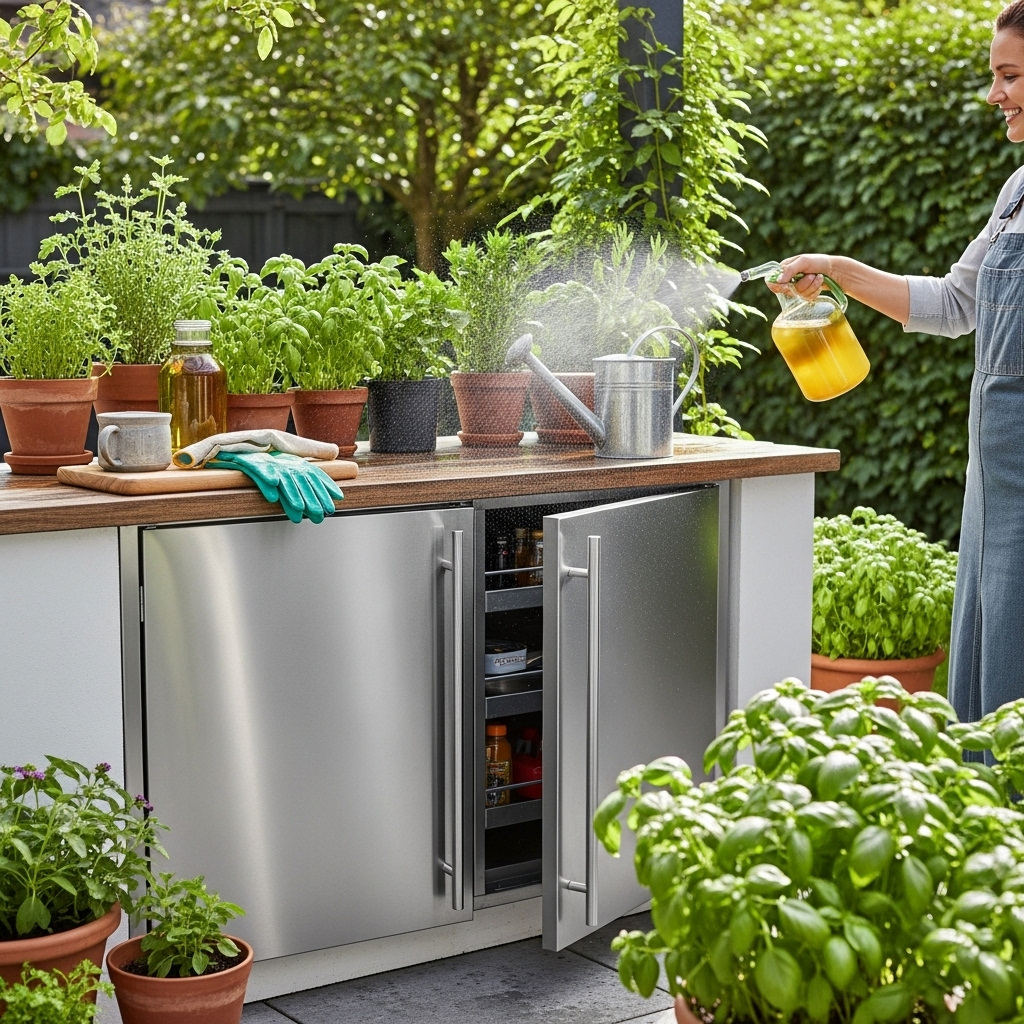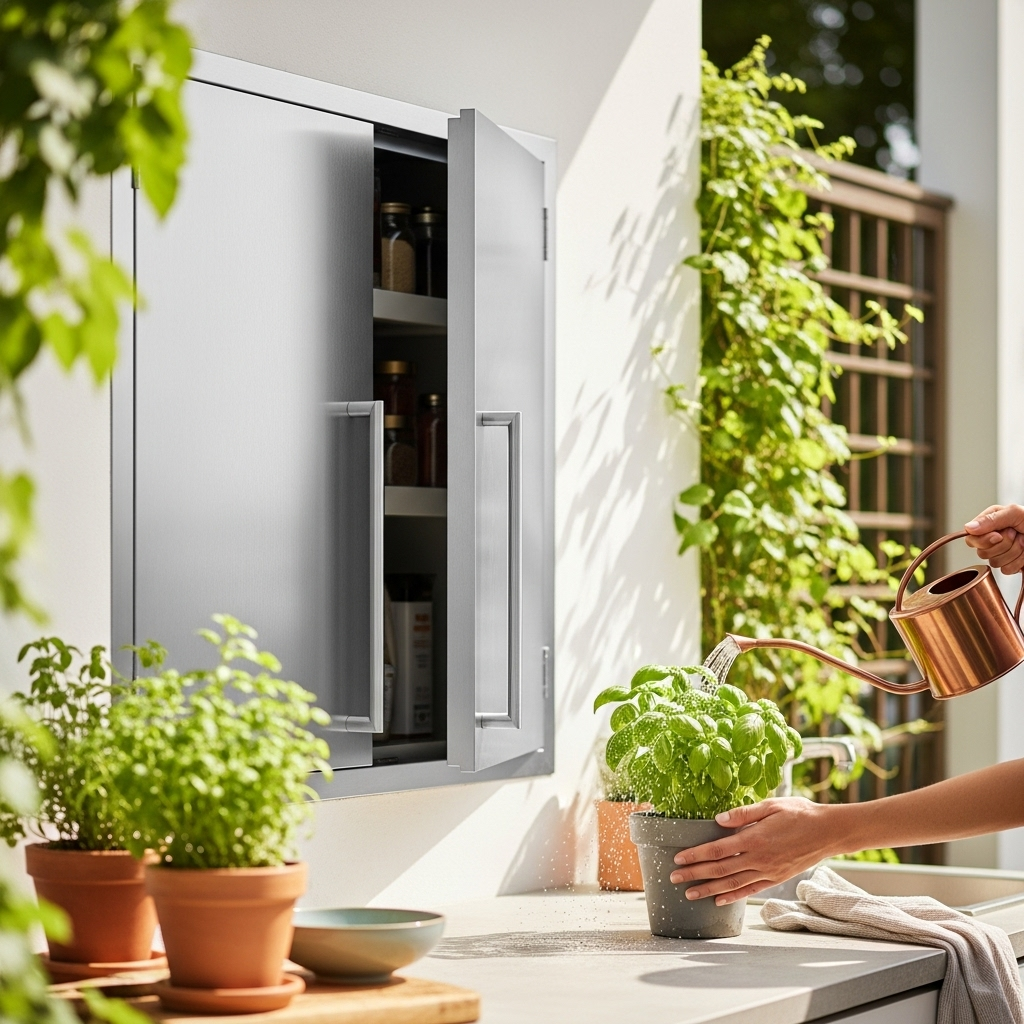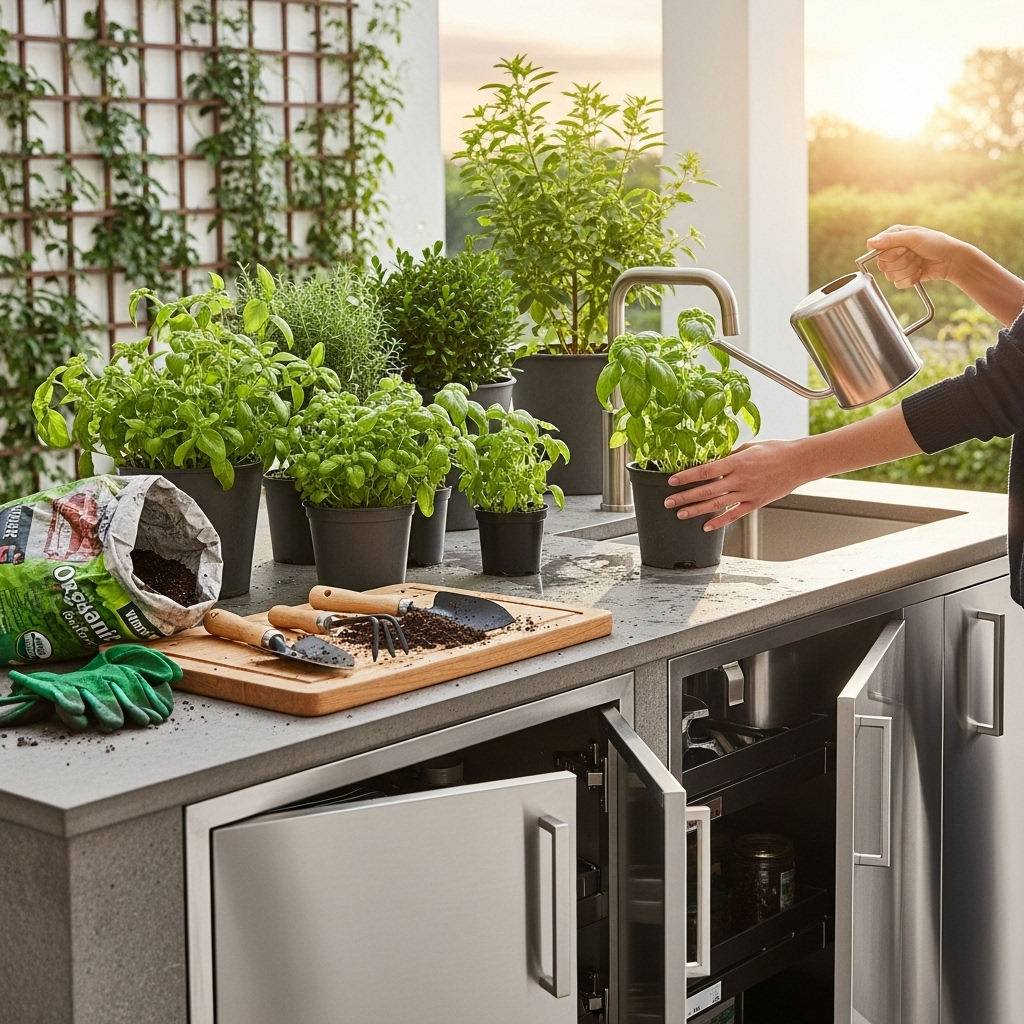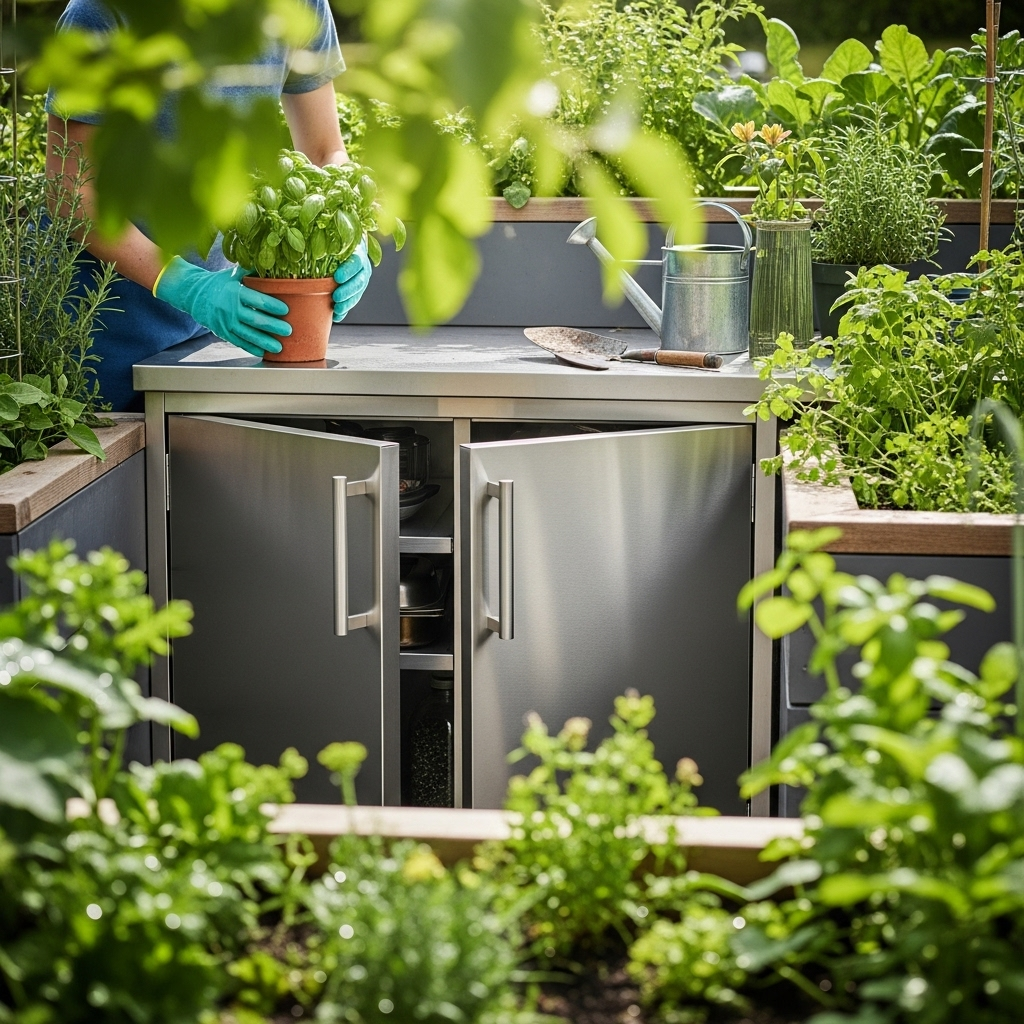Quick Summary:
Choosing stainless steel doors for your outdoor kitchen is a smart investment. They offer superior durability, weather resistance, and a sleek look that lasts, making them an essential upgrade for any homeowner looking to enhance their outdoor living space.
When building or revamping your outdoor kitchen, you want it to be both beautiful and tough. One area that often gets overlooked but makes a huge difference is the doors for your cabinets and storage areas. These little details face the brunt of the weather – sun, rain, and everything in between! That’s why opting for stainless steel doors is such a fantastic idea. They’re not just about good looks; they’re about making your outdoor kitchen a worry-free zone that stands the test of time. It might seem like a small change, but it’s one that truly elevates your outdoor cooking experience. Let’s dive into why stainless doors are a game-changer for your outdoor oasis.
Why Stainless Steel Doors Are a Game-Changer for Your Outdoor Kitchen
Think about your outdoor kitchen. It’s exposed to the elements far more than any indoor setup. Rain can soak it, sun can bleach it, and humidity can cause rust or rot in less durable materials. Standard wood, for instance, will warp and deteriorate quickly unless meticulously maintained. Even some plastics can become brittle with prolonged UV exposure. This is where stainless steel truly shines. It’s a material engineered for resilience and longevity, making it an ideal choice for the demands of an outdoor environment.
The Unbeatable Benefits of Stainless Steel
Stainless steel isn’t just a fancy name; it’s a special alloy of iron, chromium, and other elements that gives it incredible properties.
- Corrosion Resistance: The chromium in stainless steel forms a thin, invisible layer of chromium oxide on the surface. This layer acts as a shield, preventing rust and corrosion, even when exposed to moisture and salt in the air.
- Durability: It’s incredibly strong and resistant to dents and scratches, meaning your doors will look great for years to come with minimal wear and tear.
- Weatherproof: Unlike wood or many composites, stainless steel won’t warp, crack, or rot when exposed to rain, humidity, or drastic temperature changes. It handles the elements with grace.
- Low Maintenance: Cleaning is a breeze! A simple wipe-down with soap and water or a specialized stainless steel cleaner is usually all it takes to keep them looking pristine.
- Hygienic Surface: Stainless steel is non-porous, making it resistant to bacteria and easy to sanitize, which is a big plus for a food preparation area.
- Aesthetic Appeal: The sleek, modern look of stainless steel complements almost any outdoor design, adding a touch of sophistication and elegance.
Comparing Stainless Steel to Other Door Materials
Choosing the right material for your outdoor kitchen doors is crucial. Let’s see how stainless steel stacks up against common alternatives.
| Material | Pros | Cons | Outdoor Suitability |
|---|---|---|---|
| Natural Wood (e.g., Teak, Cedar) | Natural beauty, can be stained/painted | Requires regular sealing/maintenance, prone to warping, rot, insect damage, high cost for durable species. | Moderate to Poor without extensive upkeep. Prone to weathering. |
| Composite Materials (e.g., HDPE, PVC) | Water-resistant, low maintenance, comes in various colors. | Can fade in direct sunlight, may become brittle over time, less premium feel, potential for buckling. | Good, but aesthetics can degrade and material integrity can be compromised by extreme sun. |
| Powder-Coated Aluminum | Lightweight, rust-resistant, relatively affordable. | Can scratch and chip, powder coating can degrade or fade over time, not as robust as stainless steel. | Fair to Good. Offers decent weather resistance, but less durable than stainless. |
| Stainless Steel | Excellent corrosion resistance, high durability, easy to clean, premium look, very weatherproof. | Higher upfront cost, can show fingerprints (though many finishes mitigate this), can be heavier. | Excellent. Designed for harsh environments and longevity. |
As you can see, while other materials have their place, stainless steel offers a clear advantage for long-term performance and resilience in an outdoor kitchen setting.
Types of Stainless Steel Doors for Outdoor Kitchens

When you decide on stainless steel, you’re not limited to one look or style. There are several options to consider, depending on your needs and the design of your outdoor kitchen.
Cabinet Doors
These are the most common type, covering your outdoor kitchen cabinets. They can be solid panels, often with a brushed or polished finish.
- Solid Panel Doors: These offer a clean, continuous look and provide full protection to the contents of your cabinets.
- Framed Doors: These have a distinct frame around a central panel, offering a more traditional aesthetic while still being made of stainless steel.
Drawer Fronts
Drawer fronts are essentially smaller doors that finish off your drawers. They need to be equally durable and weather-resistant.
- Integrated Drawer Fronts: These are designed to be seamlessly integrated with the cabinet doors for a uniform look.
- Contrasting Drawer Fronts: Sometimes, a slightly different finish or a bolder style can be used for drawer fronts to add visual interest.
Appliance Garage Doors
If you have an appliance garage to keep your grill tools or other items tidy, stainless steel doors are perfect for this application, offering protection and style.
Specialty Doors
This can include doors for specific areas like refrigerators, ice makers, or even custom-built storage units within your outdoor kitchen.
Choosing the Right Stainless Steel Finish
The “stainless” in stainless steel comes from its composition, but the way it looks can vary greatly depending on the finish applied. The finish affects not only the aesthetics but also its resistance to fingerprints and minor scratches.
- Brushed Stainless Steel: This is perhaps the most popular finish. It has a matte, slightly textured look with visible “brush strokes” running in one direction. It’s excellent at hiding fingerprints and minor smudges, making it very practical for a high-traffic area like an outdoor kitchen.
- Polished Stainless Steel: This finish is shiny, reflective, and mirror-like. While it offers a very luxurious look, it’s also a fingerprint magnet and shows scratches more readily. It might be better for decorative elements rather than high-touch doors.
- Satin Stainless Steel: This is a smooth, non-directional finish that offers a subtle sheen. It’s less reflective than polished but more so than brushed, offering a good balance of elegance and practicality.
- Textured or Embossed Finishes: Some manufacturers offer stainless steel with subtle textures or patterns embossed into the surface. These can add a unique design element while also helping to mask smudges and minor wear.
When selecting your finish, consider how much time you want to spend cleaning and the overall aesthetic you’re aiming for. Brushed or satin finishes are generally the most forgiving for outdoor kitchens.
Key Considerations When Buying Stainless Steel Doors

Investing in stainless steel doors is a significant decision. Here are some important points to keep in mind to ensure you make the best choice for your outdoor kitchen.
Gauge and Quality of Stainless Steel
The “gauge” refers to the thickness of the metal. Lower gauge numbers indicate thicker metal. For outdoor kitchen doors, look for a thicker gauge (e.g., 18-gauge or 20-gauge is often recommended). Thicker steel is more robust, less prone to denting, and will hold its shape better over time. High-quality stainless steel, often referred to as marine-grade or 316 stainless steel, offers even better corrosion resistance, especially if you live in a coastal area with salty air. However, 304-grade stainless steel is still an excellent and widely used choice for most outdoor applications.
Construction and Craftsmanship
Don’t just look at the material; examine how the doors are made.
- Welding: Are the seams neatly welded? Poor welding can be a point of weakness and rust.
- Door Construction: Are they hollow or solid? Solid doors are generally more durable and better insulated.
- Fit and Finish: Do the doors fit snugly? Is the hardware (hinges, handles) of good quality and installed correctly? For outdoor use, using marine-grade stainless steel hardware is highly recommended to match the durability of the doors.
Hinge and Drawer Slide Quality
The doors are only as good as the hardware that supports them. For outdoor kitchens, you absolutely need heavy-duty, weather-resistant hinges and drawer slides. Look for:
- Stainless Steel Hardware: This is non-negotiable. Regular steel hinges will rust and seize up quickly.
- Sealed Bearings: For drawer slides, sealed bearings will protect against dust, dirt, and moisture.
- Adjustability: Hinges that allow for adjustment are helpful for ensuring perfect alignment even after installation.
Resources from reputable outdoor kitchen builders often emphasize the importance of component durability. For example, resources from organizations like the National Kitchen & Bath Association (NKBA) often highlight the need for durable materials and quality components in kitchen designs, which extends to outdoor spaces.
Ventilation
While stainless steel itself is weather-resistant, it’s important to consider ventilation for the cabinets behind the doors. This prevents moisture buildup, which can be especially important in humid climates or after heavy rain. Many outdoor kitchen door designs incorporate subtle vents or are designed to allow for airflow.
Size and Customization
Measure your cabinet openings precisely before ordering. Many manufacturers offer standard sizes, but custom options are also available. If you have non-standard cabinet dimensions, custom-made stainless steel doors can ensure a perfect fit and a seamless look.
Installation Tips for Your Stainless Steel Doors
While professional installation is always an option, many homeowners tackle the installation of cabinet doors themselves. Here’s a basic guide to help you get started.
Gather Your Tools
Before you begin, make sure you have the necessary tools on hand.
- Tape measure
- Screwdriver set (including Phillips head and possibly Torx bits, depending on hardware)
- Drill with appropriate drill bits (for pilot holes, if needed)
- Level
- Pencil
- Safety glasses
- Work gloves
Measure Twice, Cut Once (or Install Once!)
Double-check the dimensions of your cabinet frames and the doors you purchased. Ensure they are compatible.
Install the Hinges
- Attach hinges to the doors: Most hinges will have a plate that attaches to the door with screws. If your doors came pre-drilled, align the hinge plates with the pre-drilled holes and secure them. If not, you may need to mark and drill holes yourself, being careful to ensure they are straight and at the correct depth.
- Attach hinge base plates to the cabinet: Position the cabinet frames where you want them. Align the base plates of the hinges with the corresponding mounting locations on the cabinet frame. Use a level to ensure the cabinet is perfectly vertical and horizontal before marking and drilling pilot holes for the base plate screws. Secure the base plates.
- Mount the doors: With the base plates secured to the cabinet, carefully hang the doors by attaching the hinge arms to the base plates. Most modern hinges have a clip-on or screw-on mechanism for this step.
Adjust for Perfect Alignment
Once the doors are hung, they might not be perfectly aligned. The beauty of most cabinet hinges is their adjustability.
- In/Out Adjustment: Moves the door closer to or further from the cabinet frame edge.
- Up/Down Adjustment: Raises or lowers the door.
- Left/Right Adjustment: Moves the door horizontally to align with adjacent doors.
Make small adjustments using the designated screws on the hinges until the doors are straight, evenly spaced, and close smoothly.
Install Handles or Knobs
Mark the desired location for your handles or knobs. Drill holes if necessary and secure them firmly.
Final Check
Open and close all doors several times to ensure they operate smoothly. Wipe down the doors with a soft cloth to remove any smudges from installation.
Maintaining Your Stainless Steel Outdoor Kitchen Doors

While stainless steel is low-maintenance, a little care goes a long way in keeping your doors looking their best.
| Task | Frequency | Best Method |
|---|---|---|
| Daily Wipe-Down | After each use or daily | Soft, damp cloth to remove crumbs, spills, or light dirt. |
| General Cleaning | Weekly or as needed | Warm, soapy water and a soft cloth or sponge. Rinse thoroughly with clean water and dry with a soft, lint-free cloth to prevent water spots. |
| Deep Cleaning / Polishing | Monthly or more often if needed | Use a specialized stainless steel cleaner and polish. Always follow the grain of the steel when cleaning and polishing. This helps remove stubborn marks and restore shine. |
| Dealing with Stubborn Stains (e.g., grease, water spots) | As needed | For tough stains, a paste of baking soda and water can be effective. Apply with a soft cloth, gently rub along the grain, then rinse and dry. For water spots, vinegar diluted with water can work, but always rinse thoroughly afterwards. |
| Protecting from Harsh Chemicals | Always | Avoid abrasive cleaners, steel wool, scouring pads, or bleach-based products, as these can scratch or damage the protective layer of the stainless steel. Always use non-abrasive cloths and cleaners. |
Remember to always wipe in the direction of the “grain” of the stainless steel. This will help prevent micro-scratches and maintain a smooth, uniform appearance. For those living in coastal areas, rinsing the doors with fresh water more often can help remove salt residue that can be corrosive over time, even to stainless steel. For more in-depth cleaning advice, resources like those from the EPA’s Greener Cleaning tips can offer eco-friendly solutions that are also safe for various surfaces.
Frequently Asked Questions (FAQs)
Q1: Are stainless steel doors truly weatherproof for outdoor kitchens?
Yes, they are an excellent choice. Stainless steel is naturally resistant to rust, corrosion, and damage from rain, sun, and temperature fluctuations, making it highly weatherproof and ideal for outdoor use.
Q2: How do I clean my stainless steel outdoor kitchen doors?
For everyday cleaning, use a soft, damp cloth. For deeper cleaning, warm, soapy water is usually sufficient. Always rinse and dry with a soft, lint-free cloth, wiping in the direction of the grain. Specialized stainless steel cleaners can be used for polishing and removing stubborn marks.
Q3: Will stainless steel doors rust?
High-quality stainless steel, particularly 304 or 316 grades, is highly corrosion-resistant and unlikely to rust under normal outdoor conditions. Rusting is more common with lower grades of stainless steel or if the protective oxide layer is compromised by harsh chemicals or deep scratches.
Q4: Are stainless steel doors expensive compared to other materials?
Stainless steel doors generally have a higher upfront cost than basic wood or composite doors. However, their superior durability, longevity, and low maintenance often make them a more cost-effective option in the long run.
Q5: Can I install stainless steel doors myself?
Yes, many stainless steel cabinet doors are designed for straightforward DIY installation. Basic tools and some patience for adjustments are typically all that’s needed. Ensure you have accurate measurements and follow installation guides carefully.
Q6: Do stainless steel doors get very hot in the sun?
Like any metal, stainless steel can conduct heat. While they may become warm to the touch in direct, intense sunlight, they don’t retain heat as much as some darker materials might. Proper shading for your outdoor kitchen can also help mitigate this.
Q7: What is the best type of stainless steel for outdoor kitchens, 304 or 316?
For most standard outdoor kitchen environments, 304-grade stainless steel is an excellent choice and widely used. If your outdoor kitchen is in a harsh coastal environment with significant salt spray, 316-grade stainless steel offers superior corrosion resistance and is a better, though more expensive, option.
Conclusion: An Investment in Lasting Outdoor Enjoyment

Upgrading your outdoor kitchen with stainless steel doors is more than just adding a functional component; it’s an investment in durability, beauty, and hassle-free enjoyment of your outdoor living space year after year. The initial cost might seem a bit higher, but the peace of mind you gain from knowing your doors can withstand the elements, resist wear and tear, and remain looking stylish with minimal effort is truly invaluable.
From resisting rust and corrosion to offering a sleek, modern aesthetic, stainless steel doors provide a practical and elegant solution for all your outdoor storage needs. By considering the material quality, finish, and hardware, you can select doors that perfectly complement your design and stand up to the rigors of outdoor life. So, as you plan or enhance your outdoor cooking haven, remember the essential upgrade: stainless steel doors. They’re a choice that promises enduring quality and elevates your outdoor kitchen from a simple convenience to a lasting sanctuary. Enjoy the grilling, the gatherings, and the great outdoors with confidence in your kitchen’s resilience!
